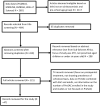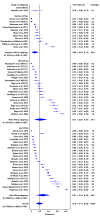A systematic review and meta-analysis quantifying schistosomiasis infection burden in pre-school aged children (PreSAC) in sub-Saharan Africa for the period 2000-2020
- PMID: 33373405
- PMCID: PMC7771669
- DOI: 10.1371/journal.pone.0244695
A systematic review and meta-analysis quantifying schistosomiasis infection burden in pre-school aged children (PreSAC) in sub-Saharan Africa for the period 2000-2020
Abstract
Introduction: Following the adoption of the World Health Assembly Resolution WHA 65.21 and Neglected Tropical Diseases road map 2021-2030, schistosomiasis control programmes have shifted from morbidity control to disease elimination. However, several gaps continue to be observed in the implementation of control programmes with certain age groups omitted from these campaigns increasing health inequalities and risks of reinfections to previously treated groups. We used the Inverse Variance Heterogeneity (IVhet) model to estimate the prevalence of schistosomiasis infection among preschool-aged children.
Methods: We did a systematic review of peer-reviewed literature on schistosomiasis in sub-Saharan Africa for the period January 1, 2000 to November 30, 2020. Quantitative data for cases of schistosomiasis infection were extracted, including country and region where the studies were done, year of publication and specific schistosome species observed. The IVhet model was used to estimate the pooled prevalence estimate (PPE), the heterogeneity and publication bias.
Results: We screened 2601 articles to obtain 47 eligible studies containing quantitative data on preschool-aged children. Of the selected studies, 44.7% (n = 22) were from East Africa while the least number of studies obtained (2.1%, n = 1) was from Central Africa. 21712 subjects were screened for infection due to Schistosoma spp; 13924 for S. mansoni and 7788 for S. haematobium. The PPE for schistosomiasis among PreSAC was 19% (95% CI: 11-28). Infection due to S. mansoni (IVhet PPE: 22% (95% CI: 9-36) was higher than that due to S. haematobium (15%; 95% CI: 6-25). A Luis Furuya-Kanamori index of 1.83 indicated a lack of publication bias. High level of heterogeneity was observed (I2 > 90%) and this could not be reduced through subgroup analysis.
Conclusion: Schistosomiasis infection among pre-school aged children 6 years old and below is high. This indicates the importance of including this age group in treatment programmes to reduce infection prevalence and long-term morbidities associated with prolonged schistosome infection.
Conflict of interest statement
The authors have declared that no competing interests exist.
Figures
Similar articles
-
Spatial distribution of schistosomiasis and treatment needs in sub-Saharan Africa: a systematic review and geostatistical analysis.Lancet Infect Dis. 2015 Aug;15(8):927-40. doi: 10.1016/S1473-3099(15)00066-3. Epub 2015 May 21. Lancet Infect Dis. 2015. PMID: 26004859
-
Impact of Schistosoma mansoni on malaria transmission in Sub-Saharan Africa.PLoS Negl Trop Dis. 2014 Oct 16;8(10):e3234. doi: 10.1371/journal.pntd.0003234. eCollection 2014 Oct. PLoS Negl Trop Dis. 2014. PMID: 25329403 Free PMC article.
-
A meta-analysis of changes in schistosomiasis prevalence in Zambia: implications on the 2020 elimination target.Parasitol Res. 2020 Jan;119(1):1-10. doi: 10.1007/s00436-019-06534-0. Epub 2019 Nov 26. Parasitol Res. 2020. PMID: 31773307 Review.
-
Prevalence and risk factors of schistosomiasis and soil-transmitted helminthiases among preschool aged children (1-5 years) in rural KwaZulu-Natal, South Africa: a cross-sectional study.Infect Dis Poverty. 2019 Jun 16;8(1):47. doi: 10.1186/s40249-019-0561-5. Infect Dis Poverty. 2019. PMID: 31202273 Free PMC article.
-
Investigating a strategy for quantifying schistosome infection levels in preschool-aged children using prevalence data from school-aged children.PLoS Negl Trop Dis. 2020 Oct 1;14(10):e0008650. doi: 10.1371/journal.pntd.0008650. eCollection 2020 Oct. PLoS Negl Trop Dis. 2020. PMID: 33001969 Free PMC article.
Cited by
-
Prevalence of soil-transmitted helminth infections, schistosomiasis, and lymphatic filariasis before and after preventive chemotherapy initiation in the Philippines: A systematic review and meta-analysis.PLoS Negl Trop Dis. 2021 Dec 20;15(12):e0010026. doi: 10.1371/journal.pntd.0010026. eCollection 2021 Dec. PLoS Negl Trop Dis. 2021. PMID: 34928944 Free PMC article.
-
Schistosoma haematobium infection and associated risk factors among pre-school age children in Gambella, Ethiopia.Parasite Epidemiol Control. 2025 Jul 1;30:e00448. doi: 10.1016/j.parepi.2025.e00448. eCollection 2025 Aug. Parasite Epidemiol Control. 2025. PMID: 40687330 Free PMC article.
-
Global distribution of zoonotic digenetic trematodes: a scoping review.Infect Dis Poverty. 2024 Jun 14;13(1):46. doi: 10.1186/s40249-024-01208-1. Infect Dis Poverty. 2024. PMID: 38877531 Free PMC article.
-
Point-of-care ultrasound reveals extensive pathology in Gabonese preschool-age children with urogenital schistosomiasis.PLoS Negl Trop Dis. 2025 Apr 10;19(4):e0012991. doi: 10.1371/journal.pntd.0012991. eCollection 2025 Apr. PLoS Negl Trop Dis. 2025. PMID: 40208908 Free PMC article.
-
Does schistosome infection affect behavior through the gut-brain axis?PLoS Negl Trop Dis. 2025 Jun 12;19(6):e0013088. doi: 10.1371/journal.pntd.0013088. eCollection 2025 Jun. PLoS Negl Trop Dis. 2025. PMID: 40504882 Free PMC article.
References
Publication types
MeSH terms
LinkOut - more resources
Full Text Sources
Miscellaneous




